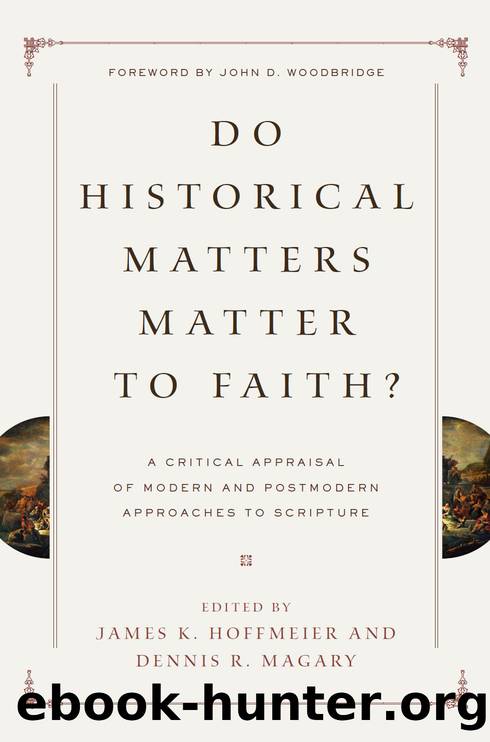Do Historical Matters Matter to Faith? by James K. Hoffmeier

Author:James K. Hoffmeier [James K. Hoffmeier and Dennis R. Magary]
Language: eng
Format: epub, mobi
ISBN: 9781433525742
Publisher: Crossway
Published: 2012-02-20T16:00:00+00:00
The Chaldeans
Use of Chaldean for a special class of learned men in Daniel is an âundoubted anachronismâ for the time of Nebuchadnezzar.16 The word in Daniel 5:30, âBelshazzar the Chaldean king,â and in 9:1, âthe realm of the Chaldeans,â has an ethnic connotation, and that may be true of the phrase âthe letters and language of the Chaldeansâ in 1:4. Every other occurrence in Daniel carries the specialized sense of a category among the wise men, sometimes standing for the whole body (cf. 2:2, 4, 10, etc.). The same restricted meaning occurs in Herodotus, Histories 1.181f., where the Chaldeans are priests of Bel. This limited meaning, it is argued, could have developed only after the Chaldeans had ceased to have any significance as a people or a power, that is, when the Persian Empire was fully established. Admittedly, the ethnic use did continue to be current for a long while, preserved in the Old Testament writings and used by historians such as Strabo at the end of the first century BC. Were Chaldean a normal gentilic in sixth-century-BC Babylonia, attested in contemporary documents, with no trace of the specialized use, Danielâs mode of employing it might be considered anachronistic. But beside the fact that there is no evidence for Chaldean as a professional name in Babylonian texts, we should note the complete absence of the word as an ethnic term from the royal inscriptions of Nebuchadnezzar, his father, and his successors. In Assyrian records of the eighth and seventh centuries it is used as the overall name for a group of tribes often mentioned separately. In this situation it is as improper to label the professional sense of Chaldean a sixth-century usage as it is to call it an anachronism.
A possible analogy can be found among the Medes. According to Herodotus, there was a group of six tribes (Histories 1.101). One of the tribes was called the Magi. Now the Magi are well known as religious functionaries in the Persian Empire and as the eponyms of all magicians. Their early history is obscure. R. N. Frye wrote, âOne may tentatively suggest that the Magi were a âtribeâ of the Medes who exercised sacerdotal functions. During the supremacy of the Medes they expanded over the Median empire as a priesthood since the priestly trade was kept, so to speak, âin the family.ââ17 Perhaps something similar was true of the Chaldeans. Chaldean has passed into English from Greek and Latin, the Greek being a correct transliteration of the Babylonian *kaldÄyu. In Hebrew the form differs: kaÅdim. The variation is explicable in the light of historical development within Babylonian and Assyrian. From the mid-second millennium BC onward the combination of sibilant + dental was often written as 1 + dental, revealing a phonetic shift probably universal in the spoken language, though concealed by scribal conservatism in many of the texts that survive.18 This shift accounts well for the difference between the Akkadian and Greek forms and the Hebrew, which was unaffected by it, deriving from the Chaldeans themselves or from a time before the shift had occurred.
Download
Do Historical Matters Matter to Faith? by James K. Hoffmeier.mobi
This site does not store any files on its server. We only index and link to content provided by other sites. Please contact the content providers to delete copyright contents if any and email us, we'll remove relevant links or contents immediately.
What Is the Gospel? (Foreword by D. A. Carson) by Greg Gilbert(970)
Daily Strength: Devotions for Bible Believing Study by Douglas Stauffer & Andrew Ray & Rick Quatro(878)
Jesus in Me by Anne Graham Lotz(848)
Christian Ethics by Wilkens Steve;(824)
The Practice Is the Path by Tias Little(797)
New Morning Mercies by Tripp Paul David(778)
Veritas: A Harvard Professor, a Con Man and the Gospel of Jesus's Wife by Ariel Sabar(710)
Cleaning Up Your Mental Mess by Dr. Caroline Leaf(707)
Greatest Mystery in the World by Og Mandino(627)
The Creative Call by Janice Elsheimer(565)
No More Christian Nice Guy by Paul Coughlin(556)
Our Appointment with Life by Thich Nhat Hanh(550)
2084 by John C. Lennox(536)
Monastic Archaeology by Unknown(526)
This One Wild and Precious Life by Sarah Wilson(517)
Jesus--Awesome Power, Awesome Love (Discover 4 Yourself® Inductive Bible Studies for Kids) by Kay Arthur(509)
The Duties of Parents by J.C. Ryle(487)
The Tale of the Tardy Oxcart (Swindoll Leadership Library) by Swindoll Charles R(469)
A Closer Talk with God: Scriptural Prayers for Women by Kim Trujillo(458)
